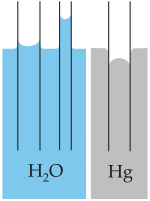
Photo from wikipedia
Abstract In order to explore the influence of cracks on capillary rise in cement based materials (CBMs), theoretical analysis of cracked and uncracked specimens is conducted in this paper. Firstly,… Click to show full abstract
Abstract In order to explore the influence of cracks on capillary rise in cement based materials (CBMs), theoretical analysis of cracked and uncracked specimens is conducted in this paper. Firstly, based on the one-dimensional Terzaghi model, a two-dimensional capillary rise model for uncracked specimens is established by considering different areas exposed to water. Then, the model is verified by experiment data. Secondly, a specimen with an ideal artificial crack is considered and a theoretical model for cracked specimens is established based on the two-dimensional capillary rise model for uncracked specimens. Finally, these theoretical models are used to analyze the influence factors during the capillary rise in cracked and uncracked specimens of CBMs. The main results show that (1) the proposed analytical method and the established models fit the experimental data well and can be used to describe the two-dimensional capillary rise as well as analyze the influence factors. (2) With the increase of area exposed to water, the rising rate of wetting front increases and the water absorption rate per area decrease. (3) The presence of cracks promotes the capillary rise for the increase of exposed area to water.
Journal Title: Construction and Building Materials
Year Published: 2020
Link to full text (if available)
Share on Social Media: Sign Up to like & get
recommendations!